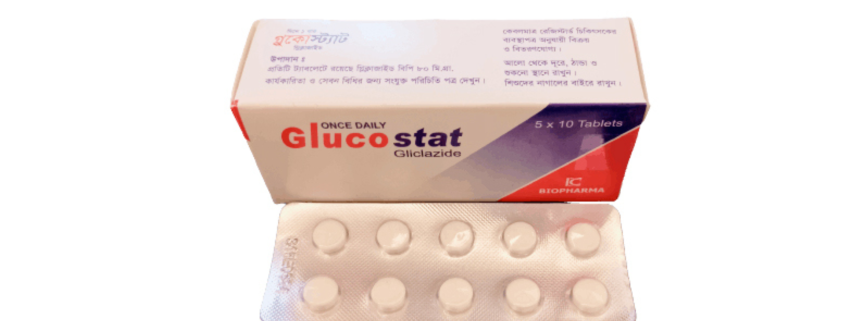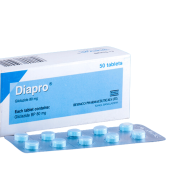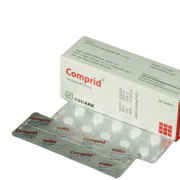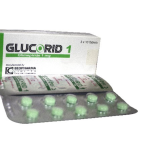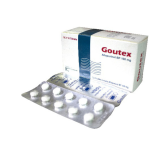Glucostat Tablet
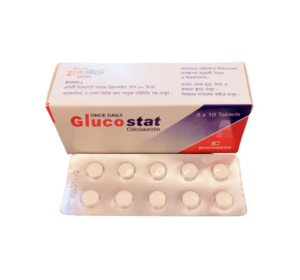
Gliclazide
80 mg
Biopharma Limited
Unit Price: ৳ 8.00 (5 x 10: ৳ 400.00)
Strip Price: ৳ 80.00
Indications
Glucostat is a medicine that reduces blood sugar levels (oral antidiabetic medicine belonging to the sulphonylurea group). Glucostat is used in a certain form of diabetes (type 2 diabetes Mellitus) in adults, when diet, exercise and weight loss alone do not have an adequate effect on keeping blood sugar at the correct level.
Pharmacology
Gliclazide is a second generation sulfonylurea drug that has hypoglycaemic and potentially useful hematological properties. It stimulates the release of insulin from pancreatic β-cells by facilitating Ca+2 transport across the β-cell membranes and decreases hepatic glucose output.
Dosage & Administration
Film-coated tablet: The usual initial dose is 40 to 80 mg daily. The dose can be increased up to 320 mg daily in divided doses when needed. The drug should be taken before meal. For children, Gliclazide is not used because it is contraindicated in juvenile-onset diabetes.
Modified release preparation: Always take this medicine exactly as your doctor or pharmacist has told you. Check with your doctor or pharmacist if you are not sure. The dose is determined by the doctor, depending on your blood and possibly urine sugar levels. Change in external factors (weight reduction, lifestyle, stress) or improvements in the blood sugar control may require changed gliclazide doses.
The recommended daily dose is one to four tablets (maximum 120 mg) in a single intake at breakfast time. This depends on the response to treatment. Gliclazide MR tablet is for oral use. Take your tablet(s) with a glass of water at breakfast time (and preferably at the same time each day). Swallow your whole tablet(s) in one piece. Do not chew or crush. You must always eat a meal after taking your tablet(s).
If a combination therapy of gliclazide with metformin, an alpha-glucosidase inhibitor, a thiazolidinedione, a dipeptidyl peptidase-4 inhibitor a GLP-1 receptor agonist or insulin is initiated your doctor will determine the proper dose of each medicine individually for you. If you notice that your blood sugar levels are high although you are taking the medicine as prescribed, you should contact your doctor or pharmacist.
If you take more Gliclazide tablets than you should: If you take too many tablets, contact your doctor or the nearest hospital Accident & Emergency department immediately. The signs of overdose are those of low blood sugar (hypoglycaemia). The symptoms can be helped by taking sugar (4 to 6 lumps) or sugary drinks straight away, followed by a substantial snack or meal. If the patient is unconscious immediately inform a doctor and call the emergency services. The same should be done if somebody, (for instance a child), has taken the product unintentionally. Unconscious patients must not be given food or drink. It should be ensured that there is always a pre-informed person that can call a doctor in case of emergency.
If you forget to take Gliclazide tablet: It is important to take your medicine every day as regular treatment works better. However, if you forget to take a dose of Gliclazide MR tablet, take the next dose at the usual time. Do not take a double dose to make up for a forgotten dose.
If you stop taking Gliclazide MR tablet: As the treatment for diabetes is usually lifelong, you should discuss with your doctor before stopping this medicinal product. Stopping could cause high blood sugar (hyperglycaemia) which increases the risk of developing complications of diabetes. If you have any further questions on the use of this product, ask your doctor or pharmacist.
Interaction
Other medicines and Glucostat: Tell your doctor or pharmacist if you are taking or have recently taken any other medicines.
The blood sugar lowering effect of Glucostat may be strengthened and signs of low blood sugar levels may occur when one of the follow ng medicines is taken:
- other medicines used to treat high blood sugar (oral antidiabetics, GLP-1 receptor agonists or insulin),
- antibiotics (sulphonamides, clarithromycin)
- medicines to treat high blood pressure or heart failure (beta-blockers. ACE-inhibitors such as captopril, or enalapril)
- medicines to treat fungal infections (miconazole, fluconazole)
- medicines to treat ulcers in the stomach or duodenum (H2 receptor antagonists),
- medicines to treat depression (monoamine oxidase inhibitors)
- painkiller or antirheumatics (phenylbutazone, ibuprofen)
- medicines containing alcohol
The blood-glucose-lowering effect of Glucostat may be weakened and raised blood sugar levels may occur when one of the following medicines is taken:
- medicines to treat disorders of the central nervous system (chlorpromazine)
- medicines reducing inflammation (corticosteroids)
- medicines to treat asthma or used during labour (intravenous salbutamol, ritodrine and terbutaline)
- medicines to treat breast disorders, heavy menstrual bleeding and endometriosis (danazol)
- St John’s Wort- Hypericum perforatum- preparations
Blood glucose disturbance (low blood sugar and high blood sugar) can occur when a medicine belonging to a class of antibiotics called fluoroquinolones is taken at the same time as Glucostat especially in elderly patients.
Glucostat may increase the effects of medicines that reduce blood clotting (warfarin).
Consult your doctor before you start taking another medicinal product. If you go into hospital tell the medical staff you are taking Glucostat.
Glucostat with food and drink: Glucostat can be taken with food and non-alcoholic drinks. Drinking alcohol is not recommended as it can alter the control of your diabetes in an unpredictable manner.
Driving and using machines: Your ability to concentrate or react may be impaired if your blood sugar is too low (hypoglycaemia), or too high (hyperglycaemia) or if you develop visual problems as a result of such conditions. Bear in mind that you could endanger yourself or others (for instance when driving a car or using machines). Please ask your doctor whether you can drive a car if you:
- have frequent episodes of low blood sugar (hypoglycaemia)
- have few or no warning signals of low blood sugar (hypoglycaemia)
Glucostat contains lactose. If you have been told by your doctor that you have an intolerance to some sugars, contact your doctor before taking this medicine.
Contraindications
Do not take Gliclazide:
- if you are allergic to gliclazide or to other medicines of the same group (sulfonylurea), or to other related medicines (hypoglycaemic sulfonamides)
- if you have insulin-dependent diabetes (type 1)
- if you have ketone bodies and sugar in your urine (this may mean you have diabetic ketoacidosis), a diabetic pre-coma or coma
- if you have severe kidney or liver disease
- if you are taking medicines to treat fungal infections
- if you are breastfeeding
Side Effects
Like all medicines, Glucostat can cause side effects, although not everybody gets them. The most commonly observed side effect is low blood sugar (hypoglycaemia). If left untreated these symptoms could progress to drowsiness, loss of consciousness or possibly coma. If an episode of low blood sugar is severe or prolonged, even if it is temporarily controlled by eating sugar, you should seek immediate medical attention.
Liver disorders: There have been isolated reports of abnormal iiver function, which can cause yellow skin and eyes. If you get this, see your doctor immediately. The symptoms generally disappear if the medicine is stopped. Your doctor will decide whether to stop your treatment.
Skin disorders: Skin reactions such as rash, redness, itching, hives, blisters, angioedema (rapid swelling of tissues such as eyelids, face, lips, mouth, tongue or throat that may result in breathing difficulty) have been reported. Rash may progress to widespread blistering or peeling of the skin. If you develop this, stop taking, seek urgent advice from a doctor and tell him that you are taking this medicine. Exceptionally, signs of severe hypersensitivity reactions have been reported: initially as flu-like symptoms and a rash on the face then an extended rash with a high temperature.
Blood disorders: Decrease in the number of cells in the blood (e.g. platelets, red and white blood cells) which may cause paleness, prolonged bleeding, bruising, sore throat and fever have been reported. These symptoms usually vanish when the treatment is discontinued.
Digestive disorders: Abdominal pain, nausea, vomiting, indigestion, diarrhoea, and constipation. These effects are reduced when Glucostat is taken with a meal as recommended.
Eye disorders: Your vision may be affected for a short time especially at the start of treatment. This effect is due to changes in blood sugar levels.
As for another sulfonylurea, the following adverse events have been observed: cases of severe changes in the number of blood cells and allergic inflammation of the wall of blood vessels, reduction in blood sodium (hyponatraemia), symptoms of liver impairment (for instance jaundice) which in most cases disappeared after withdrawal of the sulfonylurea, but may lead to life-threatening liver failure in isolated cases.
Reporting of side effects: If you get any side effects, talk to your doctor or pharmacist. This includes any possible side effects not listed in this leaflet. By reporting side effects, you can help provide more information on the safety of this medicine.
Pregnancy & Lactation
Gliclazide is not recommended for use during pregnancy. If you are pregnant, think you may be pregnant or are planning to have a baby, ask your doctor for advice before taking this medicine. You must not take Gliclazide while you are breastfeeding.
Precautions & Warnings
Talk to your doctor before taking Glucostat. You should observe the treatment plan prescribed by your doctor to achieve proper blood sugar levels. This means, apart from regular tablet intake, to observe the dietary regimen, have physical exercise and, where necessary, reduce weight During Glucostat treatment regular monitoring of your blood (and possibly urine) sugar level and also your glycated haemoglobin (HbA1c) is necessary. In the first few weeks of treatment, the risk of having reduced blood sugar levels (hypoglycaemia) may be increased. So particularly close medical monitoring is necessary.
Low blood sugar (Hypoglycaemia) may occur:
- if you take meals irregularly or skip meals altogether,
- if you are fasting
- if you are malnourished
- if you change your diet
- if you increase your physical activity and carbohydrate intake does not match this increase,
- if you drink alcohol, especially in combination with skipped meals,
- if you take other medicines or natural remedies at the same time,
- if you take too high doses of Glucostat,
- if you suffer from particular hormone-induced disorders (functional disorders of the thyroid gland, pituitary gland or adrenal cortex),
- if your kidney function or liver function is severely decreased.
if you have low blood sugar you may have the following symptoms: headache, intense hunger, nausea, vomiting, weariness, sleep disorders, restlessness, aggressiveness, poor concentration, reduced alertness and reaction time, depression, confusion, speech or visual disorders, tremor, sensory disturbances, dizziness and helplessness.
The following signs and symptoms may also occur: sweating, clammy skin, anxiety, fast or irregular heartbeat, high blood pressure, sudden strong pain in the chest that may radiate into nearby areas (angina pectoris).
If blood sugar levels continue to drop you may suffer from considerable confusion (delirium), develop convulsions, lose self-control, your breathing may be shallow and your heartbeat slowed down, you may become unconscious.
In most cases the symptoms of low blood sugar vanish very quickly when you consume .some form of sugar, (for instance, glucose tablets, sugar cubes, sweet juice, sweetened tea).
You should therefore always carry some form of sugar with you (glucose tablets, sugar cubes). Remember that artificial sweeteners are not effective. Please contact your doctor or the nearest hospital if taking sugar does not help or if the symptoms recur.
Symptoms of low blood sugar may be absent, less obvious or develop very slowly or you are not aware in time that your blood sugar level has dropped. This may happen if you are an elderly patient taking certain medicines (for instance those acting on the central nervous system and beta-blockers).
If you are in stressful situations (e.g. accidents, surgical operations, fever etc.) your doctor may temporarily switch you to insulin therapy.
Symptoms of high blood sugar (hyperglycaemia) may occur when Glucostat has not yet sufficiently reduced the blood sugar when you have not complied with the treatment plan prescribed by your doctor if you take St. John’s Wort (Hypericum perforatum) preparations or in special stress situations. These may include thirst, frequent urination, dry mouth, dry itchy skin, skin infections and reduced performance.
Blood glucose disturbances (low blood sugar and high bold sugar) can occur when Glucostat is prescribed at the same time as medicines to a class of antibiotics called fluoroquinolone, especially in elderly patients. In this case, your doctor will remind you of the importance of monitoring your blood glucose.
If you have a family history of or know you have the hereditary condition glucose-6-phosphate dehydrogenase (G6PD) deficiency (abnormality of red blood cells), lowering of the haemoglobin level and breakdown of red blood cells (haemolytic anaemia) can occur. Contact your doctor before taking this medicinal product.
Glucostat is not recommended for use in children due to lack of data.
Therapeutic Class
Sulfonylureas
Storage Conditions
Keep out of the reach and sight of children. Do not use this medicine after the expiry date which is stated on the carton and the blister. The expiry date refers to the last day of that month. Store below 30°C. Medicines should not be disposed of via wastewater or household waste. Ask your pharmacist how to dispose of medicines no longer required. These measures will help to protect the environment.
Chemical Structure
| Molecular Formula : | C15H21N3O3S |
| Chemical Structure : |
Common Questions about Glucostat 80 mg Tablet
What is Glucostat 80 mg Tablet?
Glucostat 80 mg Tablet is a medication taken orally to help manage type 2 diabetes. It works by supporting your body in controlling blood sugar levels in two ways. First, it encourages your pancreas to release more insulin. Second, it improves your body’s ability to use the insulin it already has. Thus it lowers your blood sugar levels.
What happens if I take Glucostat 80 mg Tablet without eating?
Glucostat 80 mg Tablet dosage is tied to your meals. It should be skipped if you miss a meal. If you plan to eat an extra meal, talk to your doctor about adjusting your dose for that day.
What if I missed a dose of Glucostat 80 mg Tablet?
The missed dose can be taken as soon as you remember. If it is almost time for your next dose, skip the missed dose. Do not take two doses together to make up for a missed dose.
How long does the effect of Glucostat 80 mg Tablet last?
The effect of this medicine lasts for an average duration of 24 hours.
Are there any pregnancy warnings for Glucostat 80 mg Tablet?
This medicine is not recommended for pregnant women.
General Instructions
- Take Glucostat 80 mg Tablet as directed by your doctor. This includes the dose and how often you should take it.
- The medicine should be taken by mouth (orally) 30 minutes before breakfast.
- You should monitor your blood sugar levels regularly as directed by your doctor.
- Always carry a sugary candy with you to treat hypoglycemia (low blood sugar). Consistent food intake reduces the risk of hypoglycemia.
* রেজিস্টার্ড চিকিৎসকের পরামর্শ মোতাবেক ঔষধ সেবন করুন‘

